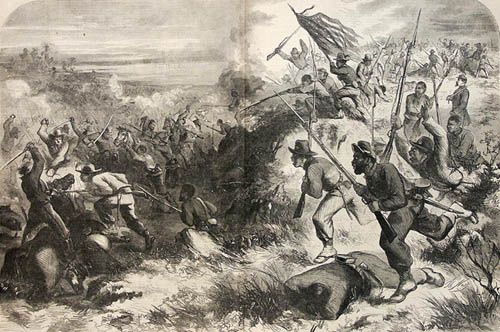The Battle of Island Mound

Image Reproduced from Harper’s Weekly
This chapter contains language that may be objectionable to the reader. Quotes contain original language to preserve authenticity of the documents.
On October 26, 1862, the 1st Kansas Colored Infantry received orders to disperse a band of bushwhackers operating near Hog Island in Bates County, Missouri. 225 men from the 1st Kansas Colored crossed the Missouri border and approached the Toothman farm north of the mound. After questioning the Toothman family and scouting the area, the 1st Kansas Colored realized they were vastly outnumbered. 400 mounted Rebel soldiers consisting of Dick Hancock’s outfit, Bill Turman’s gang of bushwhackers and men from Colonel Jeremiah Cockrell command were positioned near the mound.1 The 1st Kansas Colored constructed breastworks around the Toothman farm and named their encampment Fort Africa.
Skirmishes between the Rebels and 1st Kansas Colored took place throughout the day on October 28. The following afternoon, the Confederates approached the Union pickets from the southeast. They set fire to the prairie and forced the Union men back towards Fort Africa. Fearing an attack on their position, Capt. Henry Seaman ordered scouts to ascertain the location of the Rebels. The small party consisted of John Six-Kill, a Cherokee Indian, and his five slaves. Six-Killer and his men began skirmishing with the Rebels, which drew them south of the mound. Six-Killer’s delayed returned concerned Seaman, and Lt. Joseph Gardner was dispatched to rally Six-Killer’s party and return to camp. Gardner successfully reunited with Six-Killer but also encountered a detachment from the Rebel force. Gardner’s party of 25 men pursued the mounted Rebels by foot into the Osage Valley southeast of Island Mound.
Still positioned near Fort Africa, Capt. Richard G. Ward heard echoes from the skirmish between Gardner and Confederates. Gardner’s prolonged absence worried Ward, so he ordered Capt. Andrew Armstrong and his men north of the bluffs to identify the location of Gardner and the Rebels. Meanwhile, Gardner and his men realized they had progressed too far from Toothman’s farm, so he led the men back to Island Mound. Their retreat was perused in full force by 117 mounted Confederate soldiers.
…the enemy charged with a yell toward Gardner’s little band of twenty-five men. The boys took the double-quick over the mound in order to gain a small ravine on the north side, but while they were on the north slope the enemy came upon them. Nothing dismayed, the little band turned upon their foes, and as their guns cracked many a riderless [horse] swung off to one side. The enemy cried out to the men to surrender, but they told them never. I have witnessed some hard fights, but I never saw a braver sight than that handful of brave men fighting 117 men who were all around and in amongst them. Not one surrendered or gave up a weapon.2
Before being overrun by the Confederates, Union Lt. Elkanah Huddleston set fire to the grass on the mound to conceal their position. The fire, however, added to the confusion and became a “hellish backdrop of smoke and flame” as the bloody hand-to-hand combat ensued.3 Six-Killer was shot multiple times, but before he died, he killed four rebels – shooting two, bayoneting another, and killing a fourth with the butt of his rifle.4 Gardner was wounded with buckshot in the thigh and knee. Unable to move, he laid on the ground amongst the smoke. A Rebel soldier dismounted and approached Gardner saying he was going to finish the “d-d son of a b-h.” He placed a revolver to Gardner’s head and fired. “The ball, almost by a miracle, did not kill him; striking his skull and glancing around his head, came out the other side.”5
The initial Confederate charge carried some of the Rebels past Gardner’s position and into Capt. Armstrong’s detachment further north on the mound. Armstrong’s men fired a volley into the enemy line, which then turned to outflank Armstrong’s position. As they advanced, the Confederates met a volley from Capt. Luther Thrasher’s men. Capt. Ward positioned Lts. Minor and Dickerson to protect both Thrasher and Armstrong’s flanks, which forced the Rebels to retreat back toward Gardner’s men.6
Armstrong led his men in a charge through the smoke and fire and poured a volley into the enemy ranks. This volley dispersed the southern force and ended the battle. The 1st Kansas Colored held their ground, but they suffered ten deaths and twelve wounded. Reports indicate nearly thirty Rebel deaths, but exact numbers are uncertain. Ward noted in his report, “They did not wish ‘anymore in theirs.’ They had tested the niggers and had received an answer to the often mooted question of ‘will they fight.”7
- Chris Tabor, The Skirmish at Island Mound, Mo. (Chris Tabor, np, 2000), 9.
- U.S. War Department, The War of the Rebellion: A Compilation of the Official Records of the Union and Confederate Armies, 128 Vols. (Washington, D.C.: Government Printing Office, 1880-1901), Series I, Volume 53, 457, herafter cited as O.R..
- Tabor, The Skirmish at Island Mound, Mo., 12.
- Tabor, The Skirmish at Island Mound, Mo.,12.
- O.R. Series I, Volume 53, 457.
- Tabor, The Skirmish at Island Mound, Mo., 13.
- O.R. Series I, Volume 53, 457.













